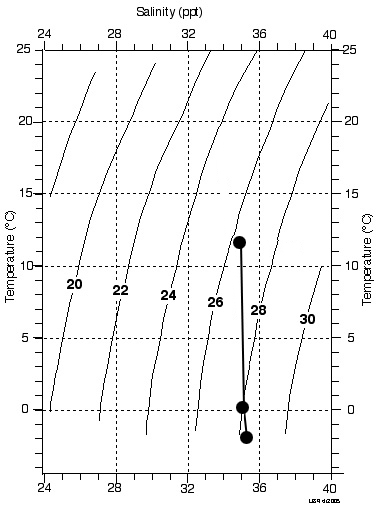
General note: The last page of your exercise has a nomogram to determine density of seawater. It's the same as Thurman & Trujillo's Figure 6-23 and 8-24, but goes to lower values of salinity. It's often useful to plot T-S-Density profiles for specific locations across the oceans, to see why the oceans differ as they do. Here's an example for Location C:
 |
Notes for specific questions:
Exercise 7, Question 1. The deepest place in the ocean will be in a trench. You thus need to locate a trench, either by recognizing the configuration of land and bathymetry near a trench or by recognizing the direction in which some seafloor is being transported.
Exercise 7, Question 2. This question can best be approached climatologically, thinking about evaporation, or perhaps geologically, thinking about Earth's most saline lake (not the Great Salt Lake), which has a plate-tectonic origin.
Exercise 7, Question 4. To estimate surface currents, you need to estimate where the wind belts are and work from there, just as you have done for the currents on Earth.
Exercise 7, Question 5. To estimate surface currents, you need to estimate where the wind belts are and work from there, just as you have done for the currents on Earth.
Exercise 7, Question 6. To understand deep circulation, you need some tracer or tracers of the movements of deep water. Temperature, salinity, and concentration of O2 are commonly used as tracers to infer the deep ocean circulation on Earth. You can contour the data from stations B, C, E, F, G, and H to discern the deep ocean circulation on Xornam.
Exercise 7, Question 7. Once you've answered Question 6, the answer to this question should be apparent too.
Exercise 7, Questions 8 to 10. To put the question another way, what difference between the deep water and the surface water has caused the deep water to sink to its present position (or caused the surface water sit above the deep water)?
- - - - - - - - - - - - - - - - -
Exercise 7, Question 0. After our consideration of plate tectonic features associated with convergent plate boundaries in Exercise 7, the lake should become apparent.
Exercise 8, Question 1. In any ocean system in which photosynthesizers remove nutrients from surface water, the deep water that has most recently left the surface will have the lowest concentrations of nutrients, and the deep water that has been down longest will have the greatest concentration of nutrients.
Exercise 8, Question 2. Productivity via photosynthesis depends on a supply of nutrients to the surface water, and a little sunshine. All you have to do is figure out where the most nutrient-rich water comes to the sea surface.
Exercise 8, Question 4. This question is asking what external factors (factors outside the Great Eastern's Seas waters) cause the deep waters to be as they are.
Exercise 8, Question 5. This question is asking what external factors (factors outside the Northern Sea's water) cause the deep waters and shallow waters to be as they are.
Exercise 8, Question 6. The deposition of carbonate oozes and chalks requires that the carbonate compensation depth be deep, which depends on the concentration of CO2 in deep water.
Exercise 8, Question7. Mn nodules grow very slowly, so they will only be found in the most slow-deposited deep-sea sediments.
Exercise 8, Question 8. Organic-rich sediments are deposited only in anoxic (O2-free) waters. If there's oxygen in the atmosphere, anoxic waters exist only in some oxygen-minimum zones and in ocean basins where the pycnocline is so strong that deep waters never mix with surface waters. You should therefore find where the strongest pycnocline is.
Exercise 8, Question 9. This question requires reviewing what was said the Paleoceanography lectures about the Cretaceous period.